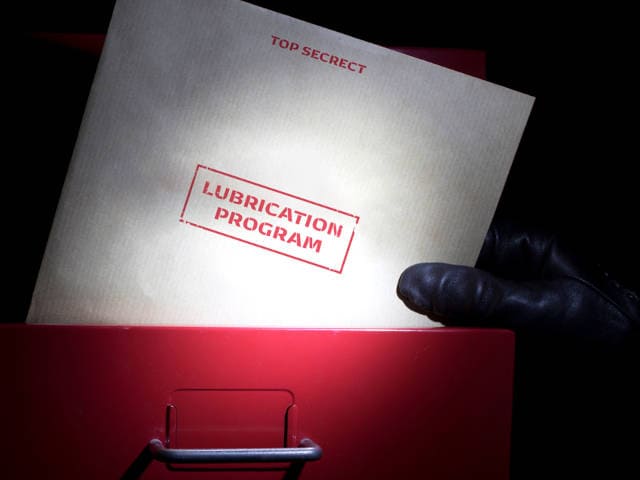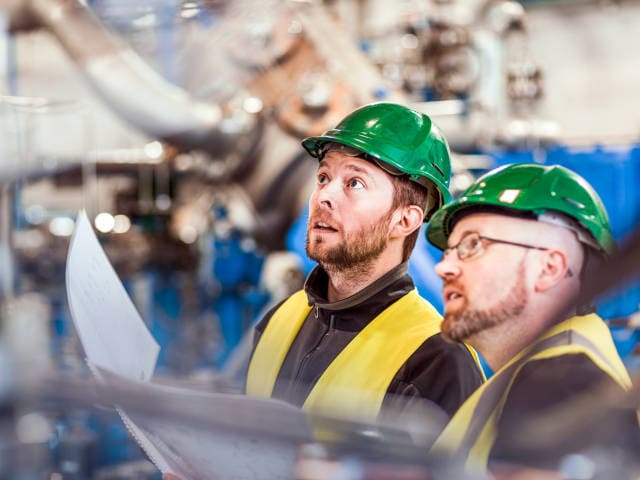The Secrets for Implementing a Clean Lubricant Program
 If you could find an investment that guaranteed a return 40 times greater than your initial investment, you probably wouldn’t pass it up. According to the Institute of Mechanical Engineers, that’s exactly the return organizations can expect when they invest in quality lubricants and best-in-class lubrication practices.
If you could find an investment that guaranteed a return 40 times greater than your initial investment, you probably wouldn’t pass it up. According to the Institute of Mechanical Engineers, that’s exactly the return organizations can expect when they invest in quality lubricants and best-in-class lubrication practices.
For every $1,000 those organizations invest in the right lubricant and the right handling, they can expect cost reductions of $40,000 in the form of increased reliability.
A proper lubrication program begins with meeting all three of the lubricant specifications for your organization’s equipment:
- Viscosity
- Performance
- Cleanliness
Achieving the first two depends primarily on selecting the right lubricant. It’s important to choose the lubricant that has the correct viscosity and the right blend of base oil and additives to provide the performance you need.
You Control Lubricant Cleanliness
 The third specification – lubricant cleanliness – is almost entirely up to you. While choosing a lubricant with the right cleanliness specifications is an important start, actual cleanliness depends largely on how your organization stores and handles the lubricant.
The third specification – lubricant cleanliness – is almost entirely up to you. While choosing a lubricant with the right cleanliness specifications is an important start, actual cleanliness depends largely on how your organization stores and handles the lubricant.
Interestingly, cleanliness is a factor many organizations overlook in the lubricants they buy and use. Many sites have failed to establish new lube cleanliness specs and overlook cleanliness when managing lubricants. But without addressing cleanliness, you cannot achieve an optimal lubrication and reliability program.
Contamination is a Significant Problem
Lubricant contamination is widely recognized as the leading cause of lubricant-related equipment failure. According to Noria, 82% of mechanical wear is caused by particle contamination in lubricants. In addition, dirt and contaminants are the leading cause of hydraulic system failures.
The types of contaminants causing the greatest damage are microscopic and can only be detected through fluid analysis. Examples include dirt particulates, moisture, varnish, and gases. Such contaminants not only damage equipment but may also reduce the performance of and shorten the intended life of the lubricant.
Organizations seeking to eliminate defects caused by equipment wear over time should be aware that lubricant cleanliness is a critical factor in wear. Starting clean by selecting the optimal lubricant for the application, changing it at the correct interval, and managing fluid cleanliness levels will all have a substantial effect on reducing and eliminating defects and improving the reliability of the entire plant.
A lack of understanding about cleanliness and pressure to reduce costs may lead some organizations to settle for lower-quality lubricants, but any cost savings are more than offset by the cost of lower productivity, premature component failure, and shortened service intervals.
Developing a Lubrication Reliability Strategy
Given the importance of lubricant cleanliness, as it relates to performance and equipment wear, organizations seeking best-in-class practices must adopt an effective strategy for lubrication reliability.
The heart of any lubricant cleanliness strategy involves what’s called “starting clean”, and that begins by selecting lubricants that meet your equipment’s requirements for viscosity, performance, and cleanliness. The next step involves obtaining a baseline assessment of the cleanliness of the new oil at an analysis laboratory (including an ISO 4406:2021 particle counting analysis).
Starting clean also requires reviewing your practices and equipment. For example, it’s important to monitor the process through which you transfer lubricants from storage and into equipment to ensure there are no opportunities for contaminants to enter via maintenance action. This includes a site’s operational discipline to maintain cleanliness by using breathers to manage the flow of air into and out of your tanks and moving to caps that are more effective at sealing. You also need to be certain your new equipment is free of other potential contaminants
Did You Know?
The act of excluding a gram of dirt or debris will only cost 10% of what it will cost to filter it out once the lubricant is contaminated.
Source: Machinery Lubrication
A proactive strategy for lubricant cleanliness may seem like extra work and expense, but any investment of time and money you make in ensuring cleanliness should deliver a significantly higher return in the form of longer equipment and part life and less maintenance-related downtime. Start clean, and be sure your lubricants meet equipment manufacturers’ cleanliness specifications.
The Secret to a Clean Lubricants Program – Eliminate Contamination Defects
 By evaluating your current program and testing the fluid cleanliness of your lubricants currently in use against your fluid cleanliness target, a baseline can be established. It is also a good idea to conduct fluid cleanliness testing for the lubricant’s chain of custody. This means testing it each time it’s touched.
By evaluating your current program and testing the fluid cleanliness of your lubricants currently in use against your fluid cleanliness target, a baseline can be established. It is also a good idea to conduct fluid cleanliness testing for the lubricant’s chain of custody. This means testing it each time it’s touched.
A comprehensive lubricant contamination defect elimination strategy will address these five areas where cleanliness defects may arise:
-
Product Selection: Set new lubricant cleanliness targets, and ensure it’s achieved at the start.
-
Product Storage: Store lubricants indoors and away from environmental exposure.
-
Design Installation: Avoid manufacturing debris that may be built inside new equipment.
-
Maintenance Action: Utilize approved lubricant tools, tip-offs, and change-out procedures.
-
Operational Discipline: Manage stored and in-use lubricant airflow with breathers.
Implementing a Clean Lubricants Program
After the defects are understood, it’s time to develop an implementation plan. There is no one plan that works for all businesses, as a wide variety of variables exist. To simplify, I’ve identified ten steps to implement a clean lubricants program:
-
Develop a Transition Plan: Use your baseline and chain-of-custody testing to understand where contamination is coming from.
-
Select Lubricant and Cleanliness Targets: Work with your OEM and/or lubricant supplier, or utilize ISO 12669, to establish the recommended cleanliness level.
-
Have the Lubricant Delivered “Certified Clean”: Ask your supplier to deliver the lubricants clean or evaluate do-it-yourself program options.
-
Prepare Storage Area: Install breathers to manage the airflow of lubricants.
-
Update and Confirm Handling Procedures: Implement the appropriate tools, such as top-off containers and eliminating funnels.
-
Update Lubrication Programs and Manuals: Update or write your Standard Operating Procedures (SOP).
-
Update Procurement System: Evaluate the minimum stock criteria in accordance with historical purchasing habits, lubricant shelf life, and lubricant rotation.
-
Monitor Fluids with Used Oil Analysis: Implement a fluid analysis program and trend the data. Look for wear rate reductions, in addition to particle count. This data can feed into and contribute to developing a predictive maintenance program.
-
Assess “Keep Clean” Tools and Services: Evaluate your goals against the fluid analysis data. If they are being achieved, move on to Step Ten. If not, go back to Step One and retrace the lubricant chain of custody to identify where additional tools or services are required to keep the lubricant clean.
-
High Five the Team: You did it! Now, it’s time to celebrate and acknowledge the hard work.
Rebecca Zwetzig was a featured speaker at the 2021 Reliable Plant Conference and Exhibition, hosted by Noria. To learn more about the yearly conference, visit conference.reliableplant.com.
